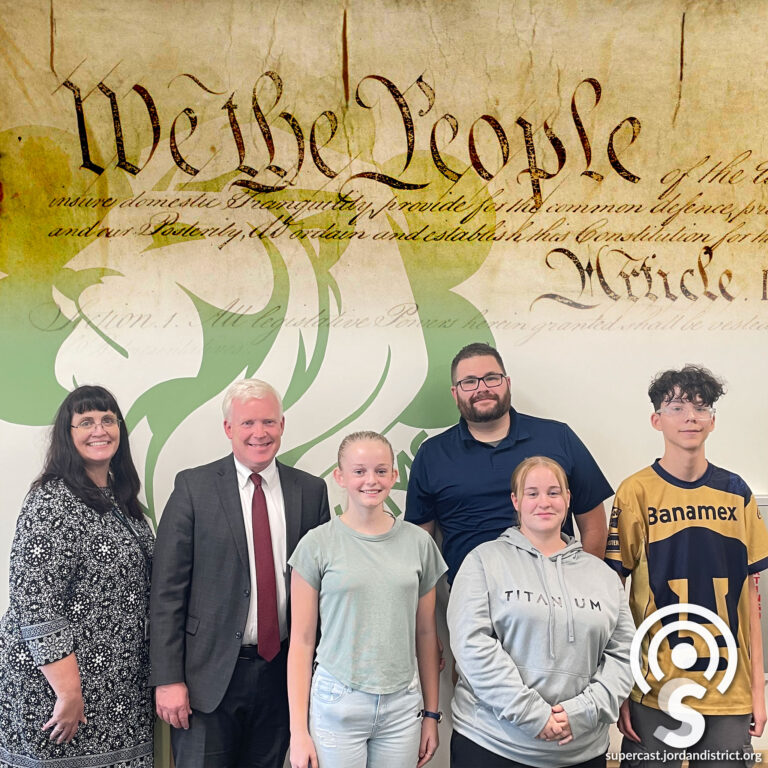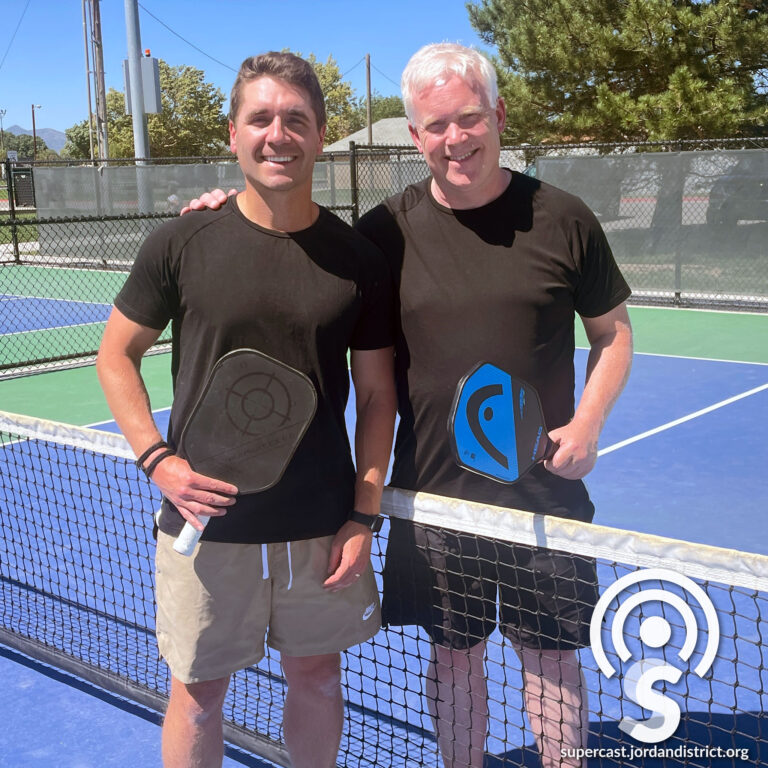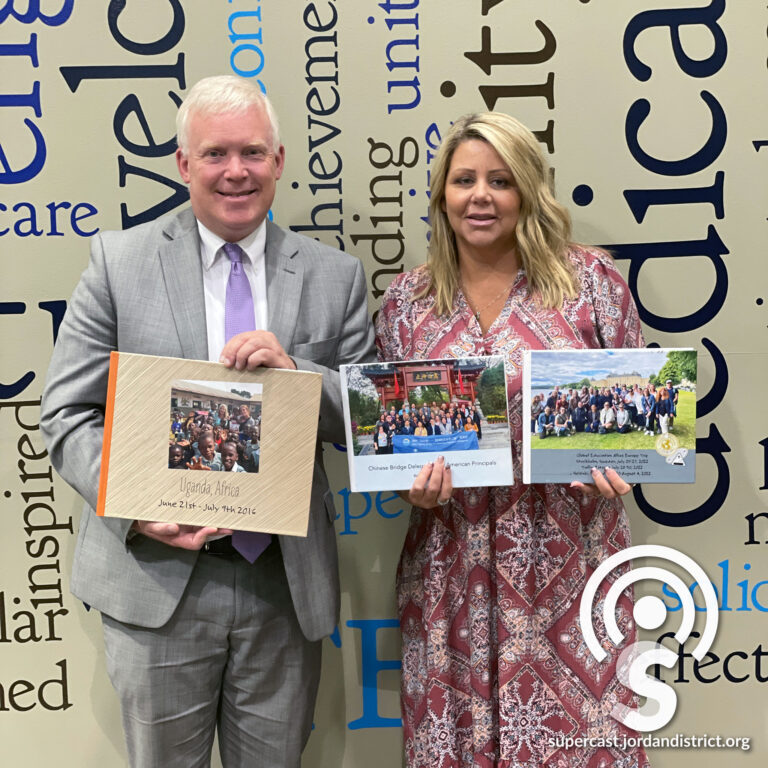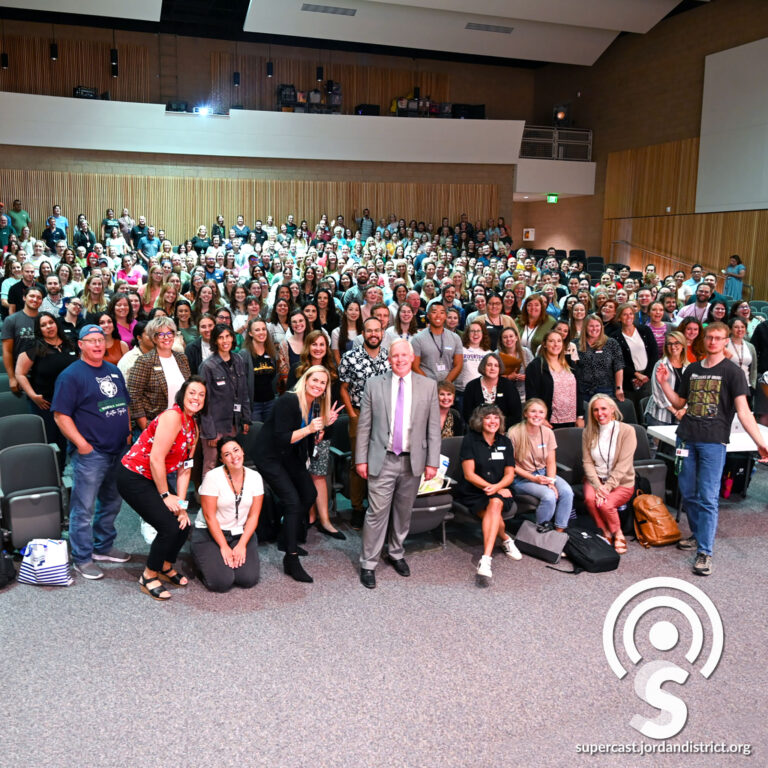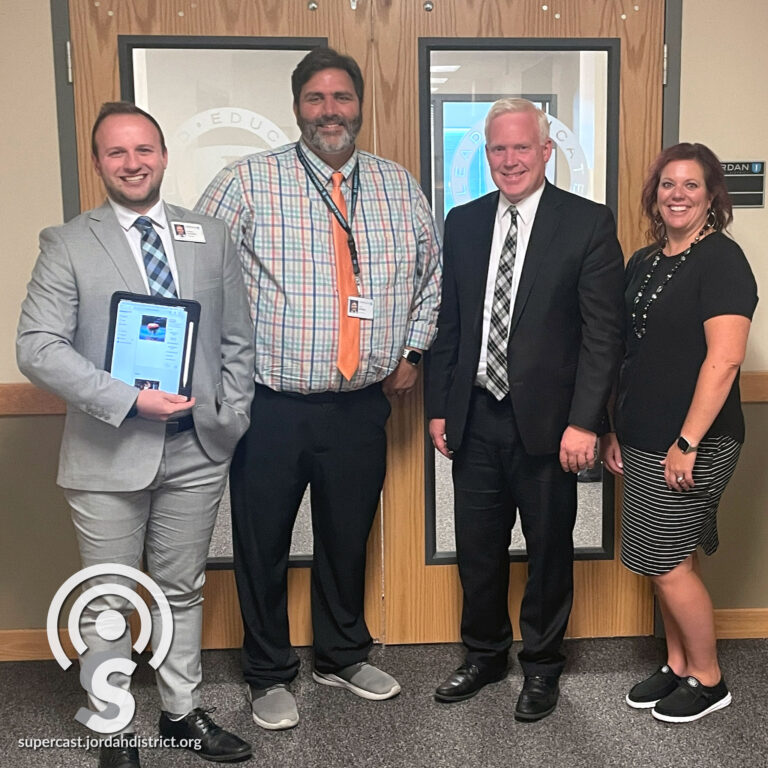Students and history teachers alike are excited to celebrate, after Governor Spencer Cox declared September “American Founders and Constitution Month” in Utah. It is a month where students are encouraged to read directly from the founding document each September 17, which is the anniversary of the creation of the Constitution in 1787.
On this episode of the Supercast, we head into West Jordan Middle School where they have a passion for learning about the Constitution and celebrate it by participating in a “We the People” competition every year.
Audio Transcription
[Music]Anthony Godfrey:
Hello and welcome to the Supercast. I'm your host, Superintendent Anthony Godfrey. Students and history teachers alike are excited to celebrate, after Governor Cox declared September “American Founders and Constitution Month” in Utah. It is a month where students are encouraged to read directly from the founding document each September 17th, which is the anniversary of the creation of the Constitution in 1787.
On this episode of the Supercast, we head into West Jordan Middle School, where they have a passion for learning about the Constitution and celebrate it by participating in a “We the People: competition every year.
We're here at West Jordan Middle School to celebrate Constitution Day and the fact that Governor Cox declared September as “American Founders and Constitution Month” here in Utah. So we have two adult Constitution experts and several student constitution experts. Go ahead and introduce yourselves before we start talking constitution.
Kaye Rizzuto:
I am Kaye Rizzuto and I am the Jordan District Social Studies Consultant.
William Shields:
My name is William Shields. I am an eighth-grade US History teacher and a ninth-grade American Institutions and Issues teacher here at West Jordan Middle School.
Anthony Godfrey:
Now tell me about those last classes that you mentioned there because those aren't offered at every one of our middle schools.
William Shields:
No, and it's actually a really cool story. After “We the People” happened a lot of students recognize that there is a large gap in the history classes from when they learned about US History from 8th grade to 11th grade, and they were really eager about wanting to keep sharp in terms of the founding documents. Keep up on connecting the past to the present and looking at those important things that make up our nation in much more depth. And it was actually driven by students. I had the wonderful opportunity to work with the counselors here, people at the district, to actually write the curriculum for it.
Anthony Godfrey:
That's fantastic. In other words, students were craving more American history at a deeper level, and you're providing that between 8th grade and 11th grade. That's fantastic.
And Kaye, tell us a little bit about your position so that those listening understand a little bit more about it.
Kaye Rizzuto:
So I am in the district office. I'm the administrator over all of social studies from kindergarten through 12th grade.
Anthony Godfrey:
And you provide great support to teachers and help us all kind of get on the same page and move forward and create a lot of space for creativity on the part of teachers and it's really exciting.
Kaye Rizzuto:
Thanks. And, I'm helping to get them supports and professional development. I actually have a team of elementary teachers working on creating curriculum for the entire state on the new elementary social studies standards.
Anthony Godfrey:
The state is wise. "Hey, we need some help. Let's go to Jordan District and grab some great teachers."
Kaye Rizzuto:
Yeah, exactly.
Anthony Godfrey:
So you mentioned “We The People”, and that's the competition that we've covered on the podcast previously, but can you describe that a little bit for those who may not be familiar with it?
William Shields:
It’s a wonderful nationwide program that was actually written between, I believe it was in the late 70s, with a combination of a Supreme Court Justice and some congresspeople, to really encourage schools to take a deeper dive into analyzing the Constitution and founding period principles and topics. And encouraging it in both an individual and a collaborative way so that the students can then work together, prepare a speech, and then respond to questions that would mimic a congressional hearing. So that's really the rundown, is it encourages students to do a deeper analysis of constitutional issues, and then prepare a defense.
Anthony Godfrey:
Well, so these students are going to know the Constitution at a deep level because they've had to question it and defend it.
William Shields:
Correct.
Anthony Godfrey:
All right, well, let's talk with them and see what they have to share with us about the Constitution. These are 9th-grade students who are now in Mr. Shields's classes to extend their American history knowledge. But last year you were all competitors in the “We the People” project. So why don't you introduce yourself and let's talk about the Constitution a little bit.
Gerardo:
I'm Gerardo. I'm in 9th grade.
Savannah:
I'm Savannah. I'm in 9th grade.
Ava:
I'm Ava and I'm in 9th grade.
Anthony Godfrey:
Why don't you tell me first of all what is your favorite amendment? It doesn't have to be the most important. They're very important, but what's your favorite? Either because it's interesting or because of the impact it had or because of the way it fit into the “We the People” competition?
Gerardo:
My favorite amendment would be the First Amendment because it talks about the rights all of us have as people living in the US.
Anthony Godfrey:
What do you think the US might look like if we didn't have a First Amendment?
Gerardo:
It would look way worse than if like some things look nowadays. Because it's never gonna be perfect, but it will look a bit less better than it is right now.
Anthony Godfrey:
And how about for you? What's your favorite amendment?
Savannah:
I agree. I think the First Amendment is one of my favorites.
Anthony Godfrey:
And why is that one your favorite?
Savannah:
I think it's important to all of the things that it covers. Talking about freedom of speech and stuff like that and how we get to express ourselves.
Anthony Godfrey:
Do you like expressing yourself as a middle school student in America?
Savannah:
I do. I think it's nice to have an opinion in certain matters.
Anthony Godfrey:
I agree. I agree. Makes our country a lot better to be able to express those opinions. And how about you?
Ava:
Mine is actually also the first.
Anthony Godfrey:
How did learning more about the Constitution for the “We the People” competition change you and the way that you view just your day-to-day life or the country or your family or school? How did it change you to learn more about the Constitution?
Gerardo:
Since I already liked history it kind of motivated me to like become a lawyer when I grow up which is one of my main interests because of this class.
Anthony Godfrey:
And is there a particular aspect of the law that you're interested in?
Gerardo::
Civil rights.
Anthony Godfrey:
Civil rights, okay great. So this may set you on a path toward a career this this class and this experience.
Gerardo:
Yeah.
Anthony Godfrey:
Well, I wish you well I'm sure you'll do great. How about for you? How has learning more about the Constitution changed you?
Savannah:
It's been interesting to learn about parts of the Constitution that you don't necessarily think about on a daily basis. And in “We the People” we got to talk about court cases. It was cool to see how the Constitution gets to defend the people in this country and how we use it in our daily lives and for things like court cases.
Anthony Godfrey:
Okay, great. And how about you?
Ava:
It helped because I never actually liked history growing up. I thought it was really boring because I never realized that in history you also learn about the Constitution and stuff like that. So when I took the class it just kind of helped me learn about other things and it actually made me want to be a lawyer too to protect certain amendments.
Anthony Godfrey:
Tell me what's it like being in Mr. Shields' class?
Gerardo:
It's a fun class and he's an interesting teacher. He's really funny and he actually helps us learn a lot from his teachings.
Anthony Godfrey:
I've seen him out and about, he's a cool cat. I expect his class would be very fun, very funny.
Savannah:
I agree. I think it's cool to see him teach. You can tell that he loves what he teaches and he puts it in phrases that makes it easy to understand for us.
Anthony Godfrey:
That's great.
Ava:
It just makes school a lot more fun. It's what I look forward to every day. He teaches us really important stuff but still makes it in a way that it's enjoyable to learn about.
Anthony Godfrey:
So if there needed to be an amendment to the Constitution to allow you to be in his class, you'd fight pretty hard for that to get put into place and ratified.
Ava:
Yes, sir.
Anthony Godfrey:
Alright. I know as part of the ‘We the People’ competition, you focus on a particular topic from the Constitution. What topic did you focus on and what can you tell me about it?
Gerardo:
My group focused on freedom of speech and we were talking about this court case versus some students who were wearing black armbands to school and we were talking about how the government was like invading their rights as humans.
Anthony Godfrey:
And did you side with the students?
Gerardo:
Yeah
Anthony Godfrey:
I thought you might have as did the Supreme Court, right?
Gerardo:
Yeah.
Savannah:
My group also talked about freedom of speech. One of the cases we got to talk about revolved around a speaker that talked to a small gathering group of members of the KKK and they were putting together a riot. And by speaking he was becoming an accessory to the crimes that they were going to commit and the things that they were going to do. We got to talk about whether his speech would be limited based on the things that he was saying and the things that he was trying to get people to do, and we got to talk a lot about criminal syndicalism laws.
Anthony Godfrey:
Wow, and should his speech have been limited?
Savannah:
Yes, by encouraging them to join in on the riot he was becoming an accessory to their crime.
Anthony Godfrey:
Okay, very good.
Ava:
My group talked about political parties and how they started. It went all the way back into the arguments between people who were running - well, I guess they weren't running for an office. But the cabinets and the vice and about what the disagreements were and why they ended up making the Republican and the Democrat parties and basically what their values are.
Anthony Godfrey:
And do you think it's good that we have those two parties?
Ava:
Yes, 100%. It helps people be able to express themselves in a way that not everybody gets to learn because it's private so not everyone has to know your opinion.
Anthony Godfrey:
Well, I'm super impressed with everything you know about the Constitution. And it's a great way for me to celebrate Constitution Day by having a chance to talk with you so thank you very much and keep up the great work.
Students:
Thanks.
Stay with us. When we come back more about what we're doing in schools to educate students about the Constitution.
Break:
Hello, I'm Sandy Riesgraf, Director of Communications for Jordan School District, and we want to invite you to connect with us. So many exciting things are happening in your child's school, your neighbor's school, in every school here, every day. Don't miss out on following the fun or simply staying informed when there's important information we need to share. Join us at jordandistrict.org, or follow us on Facebook, Twitter, and Instagram @jordandistrict. We can't wait to connect.
Anthony Godfrey:
Now let's talk a little bit about how we've commemorated the Constitution as a state and as a country over the years.
Kaye Rizzuto:
So September 17, 1787 is the day that the Constitution went into place, that it was signed, and that's why Constitution Day is on the 17th of September. Throughout the years many different states were recognizing it but eventually by 1956 President Eisenhower made September 17th and the week of September 17th, Constitution Day and Citizenship Day, to recognize the Constitution and being citizens of the United States.
Then this past spring, the Utah State Legislature wanted to increase that awareness, and they passed a bill making the month of September Founders Month so that we can honor the Constitution and our founding fathers during the month of September.
Anthony Godfrey:
When you said 1787, Schoolhouse Rock automatically starts playing in my head. Hopefully, some other listeners that's happening to you as well.
So tell me, what is it that you think people may be -- what are some misunderstandings about the Constitution that are common out there when you're teaching students or when you're talking with other folks who know that this is what you do day in and day out?
Kaye Rizzuto:
I would say that there's often some misconceptions between the Declaration of Independence and the Constitution. Like you'll hear people say the phrase, it's in the Constitution that we have the ‘life, liberty and the pursuit of happiness’, but that's actually not correct. That's in the Declaration of Independence. And so you'll see some misunderstanding about the two documents.
William Shields:
And to kind of add upon that, I think that there's a misunderstanding that the Declaration created the government that we have today. The Declaration was one of the world in history's best breakup letters with Great Britain. And so they had the early Articles of Confederation but from 1776 to 1783, excuse me 1787, it was a really weak constitution through the Articles of Confederation and in 1787 that's when the government that we have today was formally ratified. And so I think that that's one one of the big kind of learning points is the United States actually had an early constitution that wasn't the same one as we had today.
Kind of to echo what Ms. Rizzuto said, also that the Constitution is a living document. That it is something that as we see through the 27 amendments, changes can be made. But also through the impact of Marbury vs. Madison and judicial review, that we have court analysis that really does impact and reassure and reevaluate those items that are discussed within the Constitution and the amendments to make it more applicable to modern day life and situations that we face today that they didn't face in 1787.
Anthony Godfrey:
Let's talk about some of the most important amendments that you cover with students and the changes that they brought to our country.
William Shields:
Well in 8th grade we really, we have the wonderful opportunity to really take the founding period and so we start with the First Amendment and we get through what are known as the Reconstruction Amendments, so 13, 14 and 15. And every single one of them are incredibly important.
I mean first and foremost the importance, and this is towards the latter part, of the the importance of the 13th Amendment and the formal abolition of slavery. The 14th Amendment and the 15th Amendment, both the Due Process Clause, but the 14th Amendment's protection against discrimination. And so my core really kind of stops at the 15th Amendment. We take a lot of time at talking not just about what the amendments say but why.
And so currently in my class were looking at the comparative systems of those European countries that were settling in North America. And looking at, well, what did the United States later use within their constitution from these different ideas? We'll look at the philosophers. The importance, I mean, there are some historical amendments like the Third Amendment with no quartering of soldiers, which we don't really see today. But in terms of property rights, we see the Fourth Amendment all the time. And so even today in my elective class, we were talking about property rights and when is a person liable versus not liable in criminal versus civil situations.
And so within my US class, it's really an amazing analysis of those items that were important to the colonists at that time from 1 to 15. And then it's important for me to continue the story and say, listen, when you get back in 11th grade, it's gonna continue. Like the US is not done finishing the amendments with women's suffrage rights and voting granted. With things like voting term limits for the president that we'll see in the 22nd Amendment, kind of to prime the pump so they're excited to learn more about it when they get to high school.
Anthony Godfrey:
It's the ultimate cliffhanger.
William Shields:
Oh yeah.
Anthony Godfrey:
Hey, 8th grade, we're gonna leave you hanging at the 15th Amendment and then we'll pick up where we left off.
William Shields:
Oh yeah, and that's really one of those things that the students wanted. They wanted to-- they were mad. They were upset. They were like, why are we stopping here? And it was one of those things that it was– as a teacher, it was one of the biggest compliments to say–- for a student to approach me and say, I want to learn more. And I mean, I do stick to my core. But I had the opportunity to then kind of get together with this curriculum and say, OK, let's look at all 27. And not just the 27, but what were the impacting factors? You know, when have, I mean, when have there been, you know, to drop a legal term, stare decisis, when it has been continued on through judicial precedent, when has there been big changes? And so the students really are the driving force to that elective class, and it's nothing that I've been more proud of.
Anthony Godfrey:
Well, it's pretty thrilling that 14-year-olds will say, I wanna learn more about the Constitution. I'm going to use one of my elective classes to do that, to create that opportunity. So that's a great tribute to you and to our students who are so interested in our country. So tell me, what impact do you see when students learn more about the Constitution? What are some of the light bulbs that come on for them?
William Shields:
I think, I mean, I could sit here and quote the founding fathers about the importance of an educated citizenry. But to see the light in their eyes when they realize that they themselves at 8th or 9th grade, they are active citizens. That they can communicate with their local, state, and national, and federal officials if they really wanted to. To know that while they don't have the voting responsibilities and rights yet, it's important to know about the system, to know what their rights, freedoms, but also what the limitations of government are.
Anthony Godfrey:
Sure.
William Shields:
And so to really see them, to see their eyes go, this applies to me, this is important, and also to see them be able to identify how it benefits them individually, but also as a community.
Kaye Rizzuto:
One of the purposes of public education is to create good citizens, and that is done by doing these social studies courses throughout elementary school and high school and middle school. That learning about these founding fathers and the documents and all of the things that they learn in these classes is so important in helping them to learn about their role as being a good citizen. And so it's our job as educators to help prepare them to be citizens and to be active in their communities and to do their part to help the country be better.
William Shields:
I had a wonderful opportunity in previous years to talk with the Reagan Institute about the, with State Superintendent Dixon, about the importance of civil dialogue and to build that skill that is so pivotal within our constitutional republic to communicate and to know that there are gonna be different perspective and how we should build those skills to be able to process, view perspectives and have a civil conversation.
Anthony Godfrey:
The author John Meacham has talked about the fact that disagreeing is just part of who we are as Americans. And it's an important element of the strength and health of our country, I think.
Kaye Rizzuto:
And it was part of what the Founding Fathers did when they were making the Constitution. They had to have that civil dialogue, whether it was in Independence Hall or when they were off in the tavern in the evenings, they were having those dialogues and working together to form our Constitution. And it's an important skill that we need to emulate because that's how our country was built.
Anthony Godfrey:
Good thing Facebook didn't exist back then. It would’ve really gotten in the way, I think. Thank you both for everything you do to help instill a love for the Constitution and our nation in our students and for the support you give to teachers. And it's just, I'm really proud of the work that you do and the education that's provided to students around American history and the Constitution in Jordan School District. So thank you for being such an important part of that.
Kaye Rizzuto:
Thank you.
William Shields:
It's literally my pleasure and Kaye's amazing.
Anthony Godfrey:
She sure is. Thank you both.
(upbeat music)
Thanks for joining us on another episode of the Supercast. Remember, education is the most important thing you'll do today. We'll see you out there.
[MUSIC]
